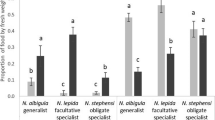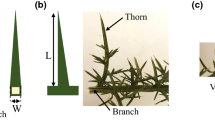Summary
We report evidence from controlled experiments that long straight thorns deter herbivory by browsers. Cut branches of three woody species that had their thorns removed suffered significantly greater herbivory by a tethered goat than did paired intact branches. Branches on living Acacia seyal plants that had their thorns removed suffered significantly greater herbivory by a wild population of free-ranging giraffes than did intact branches on the same plants. These differences in herbivory resulted in long term losses of branch length in clipped as opposed to control branches. In addition, branches within reach of giraffes produced longer thorns and a greater density of thorns than did higher branches. These results imply that increased thorn length is an induced defense.
Similar content being viewed by others
References
Abrahamson WG (1975) Reproductive strategies of dewberries. Ecology 56:721–726
Caughley G (1976) The elephant problem — an alternative hypothesis. E Afr Wildl J 14:265–283
Cole MM (1986) The savannas: biogeography and geobotany. Academic Press, London
Cooper SM, Owen-Smith N (1986) Effects of plant spinescence on large mammalian herbivores. Oecologia 68:446–455
Dagg AI, Foster JB (1982) The Giraffe: its biology, behavior, and ecology. Robert E. Krieger Publishing Co., Malabar, Florida, USA
Du Toit JT (1990) Feeding-height stratification among African browsing ruminants. Afr J Ecol 28:55–62
Du Toit JT, Bryant JP, Frisby K (1990) Regrowth and palatability of Acacia shoots following pruning by African savanna browsers. Ecology 71:149–154
Foster JB, Dagg AI (1972) Notes on the biology of the giraffe. E Afr Wildl J 10:1–16
Grimsdell JJR (1979) Changes in populations of resident ungulates. In: Sinclair ARE, Norton-Griffiths M (eds) Serengeti: Dynamics of an Ecosystem. University of Chicago Press, Chicago, pp 352–359
Hillman JC, Hillman AK (1977) Mortality of wildlife in Nairobi National Park, during the drought of 1973–1974. E Afr Wildl J 15:1–18
Hofmann RR (1973) The ruminant stomach. Stomach structure and feeding habits of East African game ruminants. East African Monographs in Biology, Vol. 2. East African Literature Bureau, Nairobi
Janzen DH (1986) Chihuahuan desert nopaleras: defaunated big mammal vegetation. Ann Rev Ecol Syst 17:595–636
Karban R, Myers JH (1989) Induced plant responses to herbivory. Ann Rev Ecol Syst 20:331–348
Kingdon J (1979) East African Mammals. An atlas of evolution in Africa. Vol. IIIB. Academic Press, London, New York
Lamprey H (1984) Woodland ecology. In: Lusigi WJ (ed) Final report on the implementation of the Integrated Project on Arid Lands phase III. UNESCO, Nairobi, pp 108–138
Leuthold BM, Leuthold W (1972) Food habits of giraffe in Tsavo National Park, Kenya. Oecologia 35:246–252
Madden D (1988) Examination of thorns and ants as features of defense for East African Acacia. MS Thesis, California State University, Fresno, CA, USA
Maier FE (1982) Effects of physical defense on vine and epiphyte growth in palms. Trop Ecol 23:212–217
Myers JH (1987) Nutrient availability and the deployment of mechanical defenses in grazed plants: a new experimental approach to the optimal defense theory. Oikos 49:350–351
Myers JH, Bazely D (1991) Thorns, spines, and prickles: are they stimulated by herbivory and do they deter herbivores? In: Tallamy D, Raup M (eds.) Herbivore-induced Phytochemical Changes in Plants. John Wiley, New York
Nobel PW (1980) Interception of photosynthetically active radiation by cacti of different morphology. Oecologia 45:160–166
Owen-Smith RN (1988) Megaherbivores. The influence of very large body size on ecology. Cambridge University Press, Cambridge
Owen-Smith RN, Cooper SM (1987) Palatability of woody plants to browsing ruminants in a South African savannah. Ecology 68:319–331
Pellew RAP (1983) The impacts of elephant, giraffe and fire upon the Acacia tortilis woodlands of the Serengeti. Afr J Ecol 21:41–74
Pellew RAP (1984) Giraffe and okapi. In: MacDonald D (ed) Encyclopedia of mammals. Facts on File, New York, pp 534–541
Pollard AJ (1986) Variation in Cnidoscolus texanus in relation to herbivory. Oecologia 70:411–413
Pollard AJ, Briggs D (1984) Geneocological studies of Urtica dioica L. III. Stinging hairs and plant-herbivore interactions. New Phyt 97:507–522
Potter DA, Kimmerer TW (1988) Do holly leaf spines really deter herbivory? Oecologia (Berlin) 75:216–221
Prins HHT, Douglas-Hamilton I (1990) Stability in a multi-species assemblage of large herbivores in East Africa. Oecologia 83:392–400
Pullin AS, Gilbert JE (1989) The stinging nettle Urtica dioica, increases trichome density after herbivore and mechanical damage. Oikos 54:275–280
Supnick M (1983) On the function of leaf spines in Ilex opaca. Bull Tor Bot Club 110:228–230
Walker BH, Emslie RH, Owen-Smith RN, Scholes RJ (1987) To cull or not to cull: lessons from a southern African drought. J Appl Ecol 24:381–401
White PS (1988) Prickle distribution in Aralia spinosa (Araliaceae). Am J Bot 75:282–285
Wyatt JR (1969) The feeding ecology of giraffe (Giraffa camelopardalis) in Nairobi National Park and the effect of browsing on their main food plants. MSc Thesis, University of East Africa, Nairobi
Young TP (1987) Herbivory induces increased thom length in Acacia drepanolobium. Oecologia (Berlin) 71:436–438
Young TP, Isbell LA (1991) Sex differences in giraffe feeding ecology: energetic and social constraints. Ethology (in press)
Young TP, Smith AP (1991) Herbivory in alpine Mount Kenya. In: Rundel P (ed) Tropical alpine systems: Plant form and function. Springer, Berlin Heidelberg New York
Author information
Authors and Affiliations
Additional information
No significance should be attached to order of authorship
Rights and permissions
About this article
Cite this article
Milewski, A.V., Young, T.P. & Madden, D. Thorns as induced defenses: experimental evidence. Oecologia 86, 70–75 (1991). https://doi.org/10.1007/BF00317391
Received:
Accepted:
Issue Date:
DOI: https://doi.org/10.1007/BF00317391




